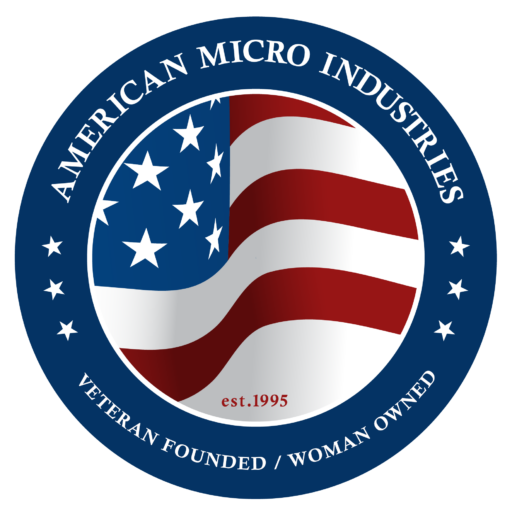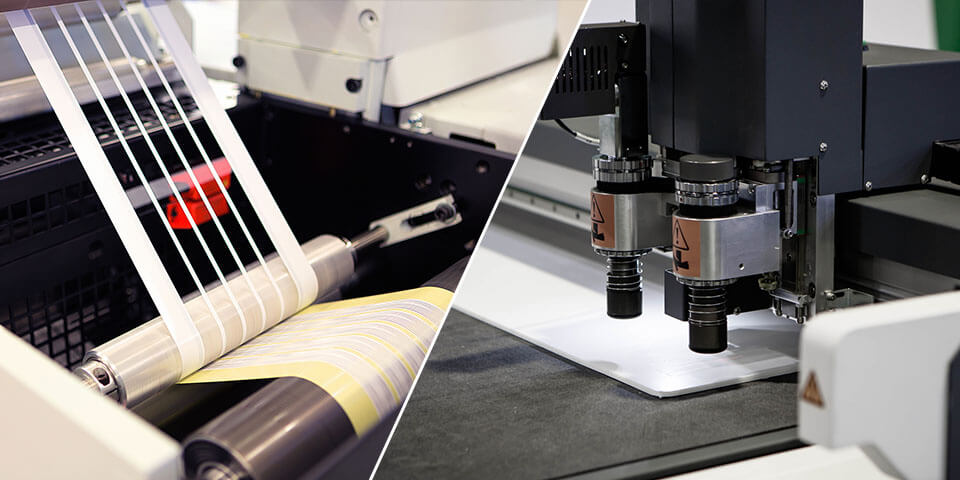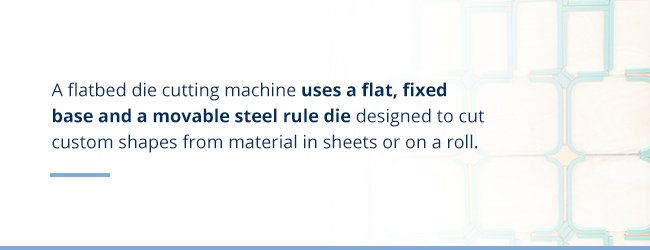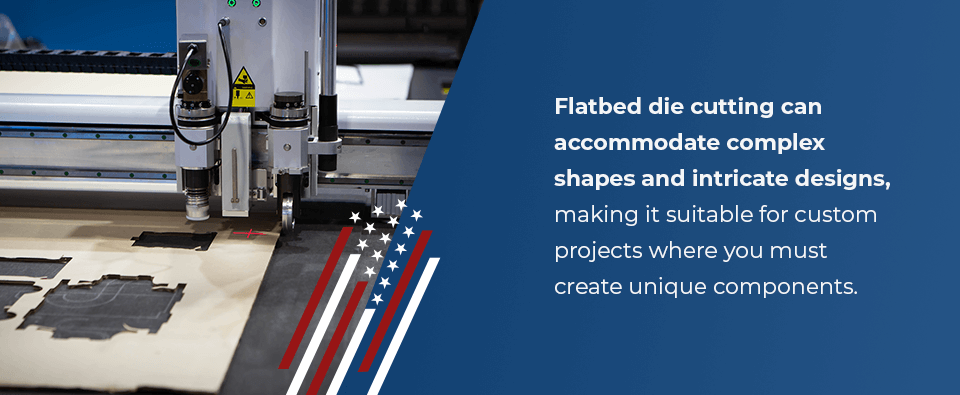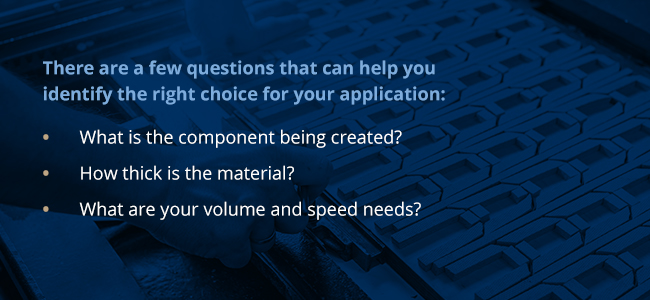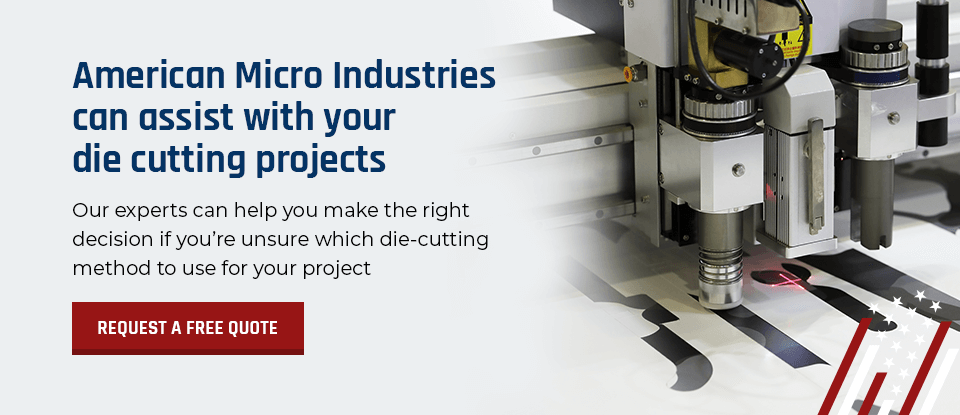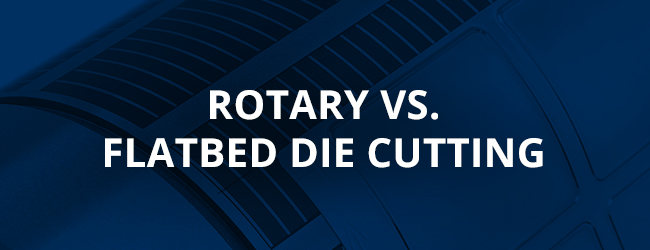
Rotary die cutting and flatbed die cutting are both fabrication processes used to cut out and form predetermined shapes from a range of materials — including metal, plastic, paper and more. It’s helpful to know the difference between rotary and flatbed die cutting so you understand the pros and cons of each and can determine which method makes the most sense for your part fabrication needs.
Rotary Die Cutting
Rotary die cutting is a popular form of die cutting. This method uses a cylindrical die that turns continuously paired with an anvil cylinder. The press feeds thin, flexible material, also known as web, between these two cylinders. The edge pinches material against the anvil cylinder, producing clean cuts or perforations. Rotary die cutting is exceptionally fast, precise and versatile, making it a good choice for many applications.
Pros of Rotary Die Cutting
There are many advantages of rotary die cutting, including:
- Efficiency: Rotary die cutting is a good choice for high-volume orders because it is so efficient. The constant rotation of the machine means that less motion is wasted compared to flatbed die cutting machines. If you have to meet rapid production demands, rotary die cutting is the better option.
- Precision: While flatbed die cutting is not imprecise, rotary die cutting offers an exceptional level of precision that surpasses flatbed machines. This high level of accuracy makes rotary die cutting a better choice for certain types of components.
- Kiss cutting: Rotary die cutting also allows you to kiss cut materials, which you cannot do with flatbed die cutting. This is an essential feature for creating stickers, labels and decals that need to be cut lightly without cutting through the backing paper.
- Multifunctionality: Rotary die cutting is versatile and can handle a variety of materials. It can also perform multiple functions, such as cutting, kiss cutting and perforating, in one process. This can streamline production and reduce the need for additional equipment.
Cons of Rotary Die Cutting
Comparing rotary die cutting vs. flatbed die cutting reveals a couple of downsides to the rotary option:
- Higher cost: Rotary die cutting is a more cost-intensive die cutting method, mainly because of the cost associated with machining the die. That said, it can still be the more cost-effective choice depending on your volume and speed needs since machined dies are extremely durable.
- Material limitations: Rotary die cutting has some limitations. The material has to be on a roller so it can feed into the machine continuously, which eliminates materials that only come in sheets. The material also has to be thin.
- Requires larger runs for cost efficiency: Rotary die cutting is more cost-effective for high-volume production runs. This method may not be as appealing for businesses that frequently produce small batches as alternatives better suited for low-volume orders.
- Limited design flexibility: If a project requires frequent design changes or even a variety of shapes, the rotary die cutting process may not be as adaptable. This can lead to potential delays and increased costs for new dies.
Flatbed Die Cutting
Another popular die cutting method is flatbed die cutting. There are mechanical, hydraulic and electric models of flatbed die cutting machines, but all these models function in a similar way. A flatbed die cutting machine uses a flat, fixed base and a movable steel rule die designed to cut custom shapes from material in sheets or on a roll. Flatbed die cutting tends to be the method of choice for general cutting applications.
Pros of Flatbed Die Cutting
Flatbed die cutting offers some notable advantages over rotary die cutting. These advantages include:
- Thick materials: One of the main ways flatbed die cutting distinguishes itself is in its capacity to cut through thicker materials. Because flatbed machines can open wide, they can cut through materials that a rotary machine could not.
- Sheet materials: Flatbed die cutting also works when your material only comes in sheets rather than rolls. With flatbed die cutting, you can feed individual sheets into the machine. This is not the case with rotary die cutting machines.
- Low cost: Flatbed die cutting is a more affordable option than rotary die cutting in many cases because tool development is fairly quick and simple. Especially if you’re doing a short-run order, flatbed die cutting is the more cost-effective choice.
- Versatility in material types: This method can work with various materials, including papers, plastics, cardboard and some metals. Its ability to accommodate different materials makes it a great choice for diverse projects across various industries.
- Design flexibility: Flatbed die cutting can accommodate complex shapes and intricate designs, making it suitable for custom projects where you must create unique components.
Cons of Flatbed Die Cutting
Though flatbed die cutting comes with some valuable advantages, you also need to consider the possible disadvantages in order to accurately compare rotary vs. flatbed die cutting:
- Slower speed: The main downside to flatbed die cutting is that it is a slower process than rotary die cutting. This may pose a problem when you have high production needs. However, some fabrication companies can still offer fairly fast turnaround times for flatbed die cutting.
- Cutting limitations: You also can’t create kiss cuts or achieve optimal accuracy with a flatbed die cutting machine. These limitations can be problematic depending on your specific application.
- Less precision: Although flatbed cutting is generally accurate, it may not achieve the same level of precision as rotary die cutting. This can be a disadvantage for projects that require exact measurements and fine details.
Choosing Between Rotary and Flatbed Die Cutting
To choose between these two methods of die cutting, you should consider the specific needs of your project. There are a few questions that can help you identify the right choice for your application:
- What is the component being created? If you need to create components with the highest level of precision or need to create kiss-cut components, you should choose rotary die cutting. Otherwise, flatbed die cutting is likely the best option.
- How thick is the material? If you need to cut components from material that is more than 1/8-inch thick, you’ll want to choose flatbed die cutting. Both rotary and flatbed die cutting are valid options when you’re working with thinner material.
- What are your volume and speed needs? If your order is high volume and you need fast turnaround times, you may want to choose rotary die cutting — though, at American Micro Industries, we offer impressively fast turnarounds for both rotary die cut and flatbed die cut parts. For small orders, flatbed die cutting is ideal.
Industry Applications
Different industries use die cutting methods based on their specific needs, including the following:
- Packaging: The packaging industry often requires the high production of boxes, labels and flexible packaging solutions. Both flatbed and rotary die cutting can accommodate various materials for this sector.
- Electronics: The electronic industry often needs designs for components like circuit boards and protective covers. Rotary die cutting makes it suitable for producing large quantities of accurate parts, ensuring consistency and quality.
- Textile: This sector uses die cutting to create patterns and other fabric components. Flatbed die cutting is suitable for cutting through multiple layers of fabric, allowing for the efficient production of intricate designs.
- Automotive: Flatbed die cutting is ideal for cutting thicker materials and complex shapes needed for gaskets, seals and insulation materials in the automotive industry.
- Medical: The medical industry requires components such as surgical drapes, bandages, and medical device packaging. Flatbed die cutting can cut for the production of various medical products while ensuring compliance with strict quality standards.
Emerging Trends and Technologies
Die cutting methods are evolving to meet the changing needs of different industries and capitalize on advanced technologies. Some emerging trends include:
- Smart manufacturing: This includes the Internet of Things (IoT) and data analytics. These smart machines can help monitor performance, optimize production schedules and predict maintenance needs, improving operational efficiency.
- Automation and robotics: Integrating automation and robotics can help streamline the die cutting processes. Automated systems can enhance production efficiency by handling tasks like material loading, unloading and cutting. This can help reduce labor costs and lead to consistent quality and faster turnaround times.
American Micro Industries serves multiple sectors, including aerospace, defense, electronics, marine, military and technology. We’re also embracing emerging trends, which allows us to optimize production schedules, perform proactive maintenance and minimize downtime.
How American Micro Industries Can Help
If you’re not sure which die cutting method makes the most sense for your application, the experts at American Micro Industries can help you make the right decision. We’ll ask for details regarding your project so we can steer you in the right direction and help meet all your part fabrication needs. We offer both die cutting options, and we understand the pros and cons of each.
When you work with American Micro Industries, you can count on us to provide great customer service, expert advice and fast turnaround times, no matter how big or small the order. Learn more about our die cutting services to see how we can assist with your next project. If you know what type of part fabrication service you’re interested in, request a free quote today.

